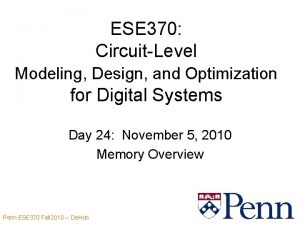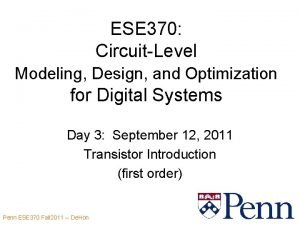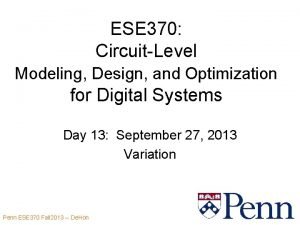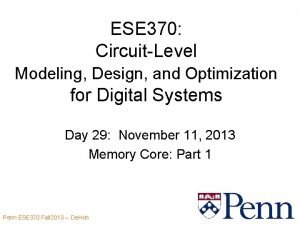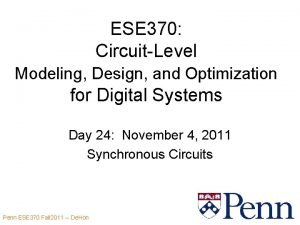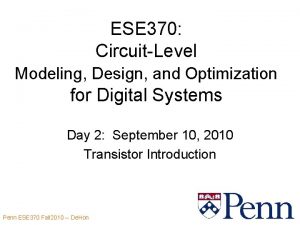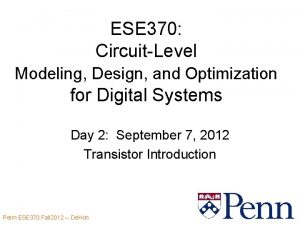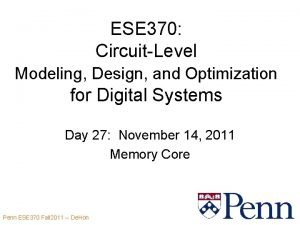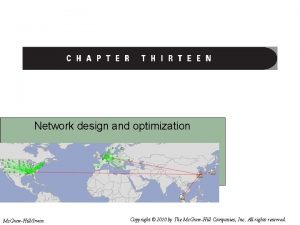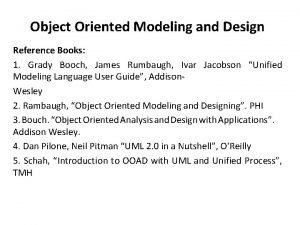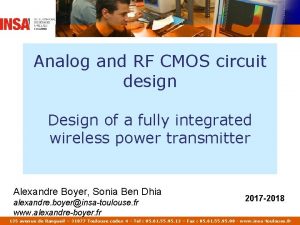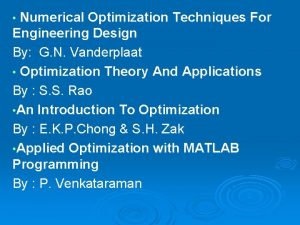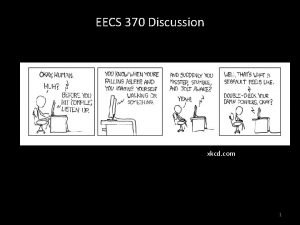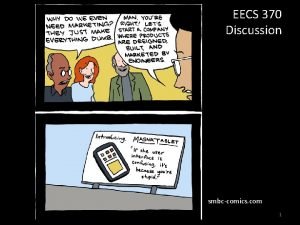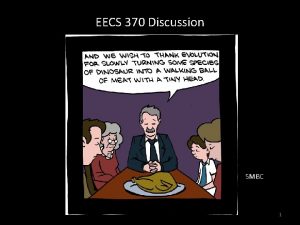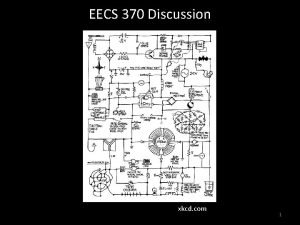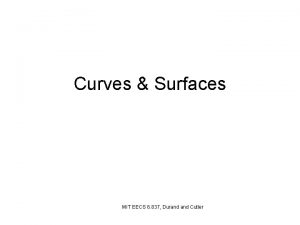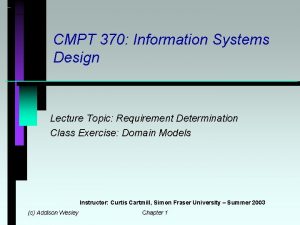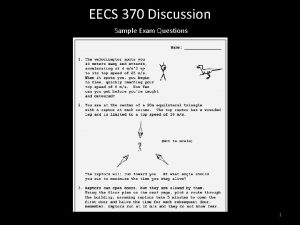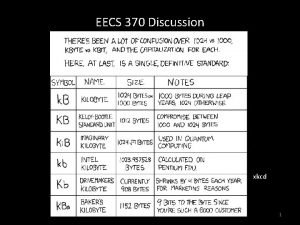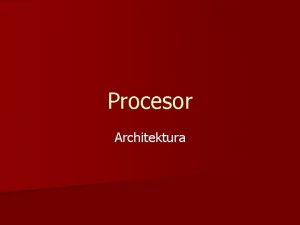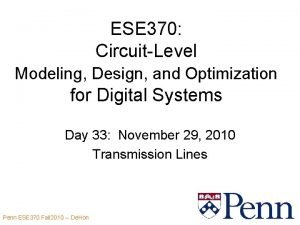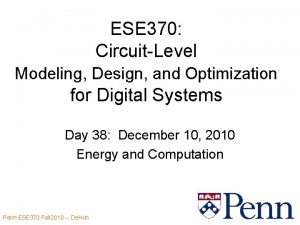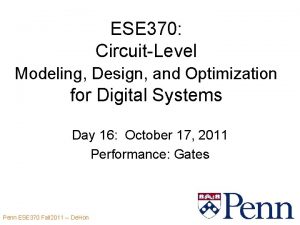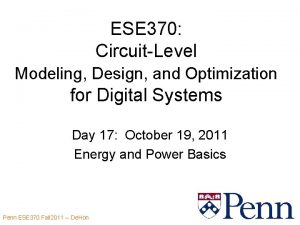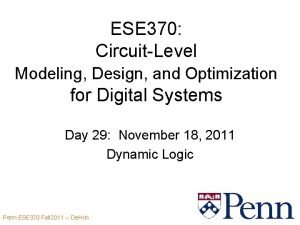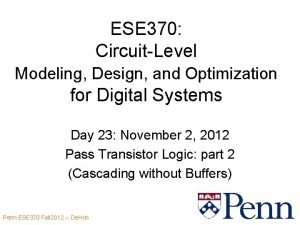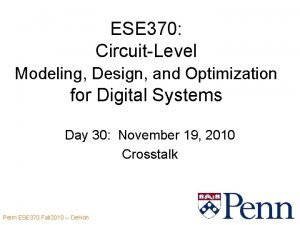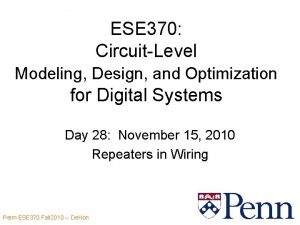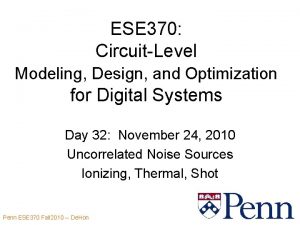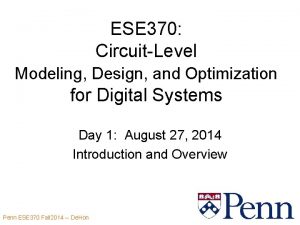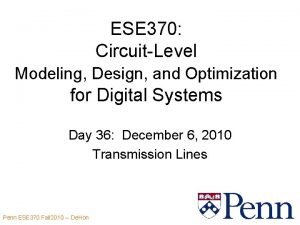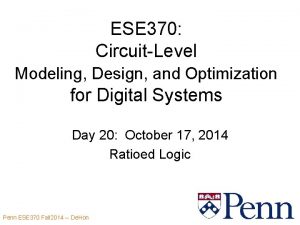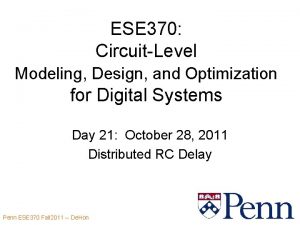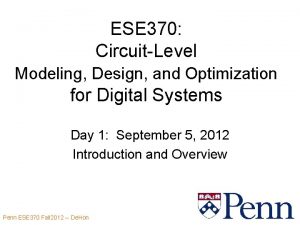ESE 370 CircuitLevel Modeling Design and Optimization for








































- Slides: 40

ESE 370: Circuit-Level Modeling, Design, and Optimization for Digital Systems Day 31: November 23, 2011 Crosstalk Penn ESE 370 Fall 2011 -- De. Hon 1

Today • Crosstalk – How arise – Consequences – Magnitude – Avoiding Penn ESE 370 Fall 2011 -- De. Hon 2

Capacitance • There are capacitors everywhere • Already talked about – Wires as capacitors – Capacitance between terminals on transistor Penn ESE 370 Fall 2011 -- De. Hon 3

Miller Effect • For an inverting gate • Capacitance between input and output must swing 2 Vhigh • Or…acts as doublesized capacitor Penn ESE 370 Fall 2011 -- De. Hon 4

Capacitance Everywhere • Potentially a capacitor between any two conductors – On the chip – On the package – On the board • All wires – – Package pins PCB traces Cable wires Bit lines Penn ESE 370 Fall 2011 -- De. Hon 5

Capacitor Dependence • Decrease with conductor separation • Increase with size • Depends on dielectric Penn ESE 370 Fall 2011 -- De. Hon 6

Parallel Wires • Parallel-plate capacitance between wires Penn ESE 370 Fall 2011 -- De. Hon 7

Wire Capacitance • Changes in voltage on one wire may couple through capacitance to another Penn ESE 370 Fall 2011 -- De. Hon 8

Consequences Qualitative First Penn ESE 370 Fall 2011 -- De. Hon 9

Driven Wire • What happens to a driven wire? Penn ESE 370 Fall 2011 -- De. Hon 10

Driven Wire • Can this be a problem? • Victim – Clock line – Asynchronous control – Non-clock used in synchronous system • Outputs sampled at clock edge Penn ESE 370 Fall 2011 -- De. Hon 11

Undriven Wire • What happens to undriven wire? • Where do we have undriven wires? Penn ESE 370 Fall 2011 -- De. Hon 12

Clocked Logic • CMOS driven lines • Clocked logic • Willing to wait to settle • Impact is solely on delay – May increase delay of transitions Penn ESE 370 Fall 2011 -- De. Hon 13

Magnitude Quantitative Penn ESE 370 Fall 2011 -- De. Hon 14

How large is the noise? • V 1 transitions from 0 to V? Penn ESE 370 Fall 2011 -- De. Hon 15

How large is the noise? • V 1 transitions from 0 to V Penn ESE 370 Fall 2011 -- De. Hon 16

Noise Magnitude Penn ESE 370 Fall 2011 -- De. Hon 17

SPICE C 1=10 p. F, C 2=20 p. F Penn ESE 370 Fall 2011 -- De. Hon 18

Good (? ) Capacitance • High capacitance to ground plane – Limits node swing from adjacent conductors Penn ESE 370 Fall 2011 -- De. Hon 19

Driven Line • What happens when victim line is driven? Penn ESE 370 Fall 2011 -- De. Hon 20

Driven Line • Driven line – Recovers with time constant: R 2(C 1+C 2) Penn ESE 370 Fall 2011 -- De. Hon 21

Spice: R 2=1 K, C 1=10 p. F, C 2=20 p. F Penn ESE 370 Fall 2011 -- De. Hon 22

Magnitude of Noise on Driven Line • Magnitude of diversion depends on relative time constants – t 1, t 2 – t 1<< t 2 • full diversion, then recover – t 1>> t 2 • Charge capacitor faster than line 1 can change – little noise Penn ESE 370 Fall 2011 -- De. Hon 23

Magnitude of Noise on Driven Line • Magnitude of diversion depends on relative time constants – t 1, t 2 – t 1<< t 2 – t 1>> t 2 Penn ESE 370 Fall 2011 -- De. Hon 24

Spice: C 1=1 p. F, C 2=2 p. F Penn ESE 370 Fall 2011 -- De. Hon 25

Simultaneous Transition • What happens if transition in opposite directions? Penn ESE 370 Fall 2011 -- De. Hon 26

Simultaneous Transition • What happens if transition in opposite directions? – Must charge C 1 by 2 V – Or looks like 2 C 1 between wires Penn ESE 370 Fall 2011 -- De. Hon 27

Where Arise Penn ESE 370 Fall 2011 -- De. Hon 28

Cables and PCB Wires Source; http: //en. wikipedia. org/wiki/File: Flachbandkabel. jpg Penn ESE 370 Fall 2011 -- De. Hon 29

Printed Circuit Board Source: http: //en. wikipedia. org/wiki/File: Testpad. JPG Penn ESE 370 Fall 2011 -- De. Hon 30

Interconnect Cross Section Penn ESE 370 Fall 2011 -- De. Hon ITRS 2007 31

IC Metalization Source: http: //en. wikipedia. org/wiki/File: Silicon_chip_3 d. png Penn ESE 370 Fall 2011 -- De. Hon 32

Standard Cell Area All cells uniform height inv nand 3 Cell area Width of channel determined by routing Identify the full custom and standard cell regions on 386 DX die http: //microscope. fsu. edu/chipshots/intel/386 dxlarge. html 33 Penn ESE 370 Fall 2011 -- De. Hon

Wires • Will be capacitively coupled to many adjacent wires of varying degrees Penn ESE 370 Fall 2011 -- De. Hon 34

bit lines, word lines wordline bitline Penn ESE 370 Fall 2011 -- De. Hon 35 Source: http: //techon. nikkeibp. co. jp/article/HONSHI/20071219/144399/

Addressing Penn ESE 370 Fall 2011 -- De. Hon 36

What can we do? • How can we reduce? Penn ESE 370 Fall 2011 -- De. Hon 37

What can we do? • Orthogonal routing layers – Avoid parallel coupling vertically • Widen spacing between wires – Particularly critical path wires • Limit length two wires run in parallel • Separate with power planes • Separate with ground/power wires Penn ESE 370 Fall 2011 -- De. Hon 38

Admin • HW 6 Out by time return from break • Next week – Project 3 out – Lecture Monday and Wednesday – Lab on Friday Penn ESE 370 Fall 2011 -- De. Hon 39

Idea • • Capacitance is everywhere Especially between adjacent wires Will get “noise” from crosstalk Clocked and driven wires – Slow down transitions • Undriven wires voltage changed • Can cause spurious transitions Penn ESE 370 Fall 2011 -- De. Hon 40
 Ese 370
Ese 370 Gate ese
Gate ese Ese 370
Ese 370 Ese 370
Ese 370 Ese 370
Ese 370 Ese 370
Ese 370 Ese 370
Ese 370 Ese 370
Ese 370 Helen c. erickson nursing theory
Helen c. erickson nursing theory Relational vs dimensional data modeling
Relational vs dimensional data modeling Network design and optimization
Network design and optimization Dfd ch5
Dfd ch5 System requirements checklist output example
System requirements checklist output example Object-oriented modeling and designs books
Object-oriented modeling and designs books Device modeling for analog and rf cmos circuit design
Device modeling for analog and rf cmos circuit design Numerical optimization techniques for engineering design
Numerical optimization techniques for engineering design Loader design options
Loader design options Umich eecs 496
Umich eecs 496 Ibm 360 instruction format
Ibm 360 instruction format Eecs370
Eecs370 Eecs 370
Eecs 370 Eecs 370 project 4
Eecs 370 project 4 Acq 370
Acq 370 Eecs370
Eecs370 Eecs 370 curve
Eecs 370 curve Cmpt 370
Cmpt 370 Csc 370
Csc 370 Csc 370
Csc 370 Eecs 370 project 2
Eecs 370 project 2 53 hangi onluğa yuvarlanır
53 hangi onluğa yuvarlanır Eecs 370 curve
Eecs 370 curve Www.infinisource.com register
Www.infinisource.com register 460 democritus atom model
460 democritus atom model Eecs 370
Eecs 370 Isy 370
Isy 370 Architektura cpu
Architektura cpu Ibm 370 series
Ibm 370 series Csc 370
Csc 370 Acq 370
Acq 370 Fspos vägledning för kontinuitetshantering
Fspos vägledning för kontinuitetshantering Novell typiska drag
Novell typiska drag
